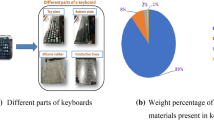Abstract
An issue with old cardboard container recycling is the generation of a plastic waste stream that currently either gets land-filled or burned. The contents of this rich plastic waste, which constitutes 35% of the exiting stream, are not well documented. This study is aimed at characterizing the plastic waste stream for engineering new second life products. The plastic waste from a Wandel screen processing unit was composed typically of hot melt adhesives (37%), polypropylene (32%), polyethylene (17%), and polystyrene (9%). Proportions varied 10% or less in each polymer category. The plastic waste was compounded, milled and injection molded into test specimens. DSC analysis showed that the polymers exist generally in separate phases. TGA thermograms determined that the onset degradation (405°C) of the mixed stream is an average of its components. In tensile tests, the mixed plastic waste stream performed comparably to its starting materials with a modulus of 9.6 MPa, ultimate strength of 8.7 MPa, and toughness of 52.6 J.











Similar content being viewed by others
References
Recycling Statistics: Corrugated packaging alliance. http://www.corrugated.org/Recycling/RecyclingStats.aspx(2008). Accessed 5 Sept 2011
Smook, G.: Handbook for pulp and paper technologists, pp. 209–218. Angus Wilde Publications, Vancouver (1992)
Guide for Industrial Wastes: Environmental Protection Agency (EPA). http://www.epa.gov/epawaste/nonhaz/industrial/guide/index.htm(2011). Accessed 7 Sept 2011
Municipal Solid Waste Report 2009: Full Report, EPA. http://www.epa.gov/osw/nonhaz/municipal/msw99.htm (2009). Accessed 7 Sept 2011
Municipal Solid Waste Report 2005: Full Report. EPA. http://www.epa.gov/osw/nonhaz/municipal/msw99.htm (2005). Accessed 7 Sept 2011
Fowler, C.: Status of northern fur seals on the Pribilof Islands. Background paper submitted to the 26th annual meeting of the standing scientific committee of the North Pacific Fur Seal Commission, Washington (1983)
Serranti, S., Bonifazi, G.: Post-consumer polyolefin (PP-PE) recognition by combined spectroscopic sensing techniques. Open Waste Management Journal 3, 35–45 (2010)
Mayo, D., Miller, F., Hannah, R.: Course notes on the interpretation of infrared and raman spectra. Wiley-Interscience, New Jersey (2004)
Mathias, L.J., et al.: Quantitative analysis by FTIR: Thin films of ethylene vinyl acetate. J Chem Ed 69(8), A217–A219 (1992)
HMA-EVA based: Special Chem. http://www.specialchem4adhesives.com/tc/uv-light-stabilizers/index.aspx?id=eva (2011). Accessed 9 Sept 2011
Nardin, M., et al.: Effects of the composition of hot-melt adhesives on their bulk and interfacial properties. Journal de Physique 4, Colloque C7, Supplement au. Journal de Physique 3(13), 1505–1510 (1993)
Guideline for forensic examination of pressure sensitive tapes: FBI Forensic Science Communications (2008). http://www.fbi.gov/about-us/lab/forensic-science-communications/fsc/ oct2008/standards/2008_10_standards02.htm (2011). Accessed 22 Sept 2011
Doshi, M., Dyer, J.: Removal of wax and stickies from OCC by froth floatation, DOE Project DE-FC07-97ID 13563, TAPPI Technical Conference (2003)
Douek, M., et al.: An overview of the chemical nature of deposits/stickies in mills using recycled fibre. TAPPI recycling symposium proceedings pp 313–330 (1997)
Wilkie, C.: TGA/FTIR: An extremely useful technique for studying polymer degradation. Polym. Degrad. Stab. 66, 301–306 (1999)
Chan, J.H., et al.: The thermal degradation kinetics of polypropylene: Part III. Thermogravimetric analyses. Polym. Degrad. Stab. 57, 135–149 (1997)
Fernandez, E.: Thermal characterization of 3-component blends for hot-melt adhesives. J. Appl. Polm. Sci. 80(14), 2889–2901 (2001)
Ethylene vinyl acetate hot melt glue. MSDS Emhart Canada Ltd. http://www2.itap.purdue.edu/msds/docs/5427.pdf. Accessed 19 Oct 2011
Brandrup, J., Immergut, E. H., Grulke, E. A.: Polymer handbook. Wiley-Interscience, II 425–II 453, V 164–V 166
Maier, C.: Polypropylene: The definitive user’s guide. William Andrew Publishing, New York, N.Y. (1998)
Thirtha, V., et al.: Morphological effects on glass transition behavior in selected immiscible blends of amorphous and semi-crystalline polymers. Polymer 47(15), 5392–5401 (2006)
Silquest 597 Silane: adhesion promoter for hot melt adhesives. Momentum performance materials. http://www.momentive.com/momentiveInternetDoc/ (2011). Accessed 26 Sept 2011
Data Sheet- Scotch box Sealing Tape 313. 3 M Cooperation. http://multimedia.mmm.com/mws/mediawebserver.dyn?6666660Zjcf61Vs6EVs666&ycCOrrrrQ-. Accessed 26 Sept 2011
Data Sheet- Scotch Weld Hot Melt Adhesive. 3 M cooperation. http://www.tapecase.com/p.129.35/3m-3762-3m-scotch-weld-hot-melt-adhesive.aspx (2011). Accessed 23 Sept 2011
Ethylene Vinyl Acetate (EVA) Copolymers (>50% Ethylene)—market report. The Chemquest Group, Inc. http://www.chemquest.com/store/ethylene-vinyl-acetate-copolymers-european-adhesives.html (2011). Accessed 23 Sept 2011
Meran, C., et al.: Examination of the possibility of recycling and utilizing recycled polyethylene and polypropylene. Mater. Des. 29(3), 701–705 (2009)
Acknowledgments
Smurfit Stone Container Cooperation for partial project funding and materials. Diversified Plastics (Missoula, MT) for assistance with plastic processing. The FTIR spectrometer was supported by USDA-CSREES-NRI grant number 2005-35103-15243.
Author information
Authors and Affiliations
Corresponding author
Rights and permissions
About this article
Cite this article
Sardot, T., McDonald, A.G. & Smith, G. Characterization of a Cardboard Recycling Facility’s Mixed Plastic Waste for Beneficial Use. Waste Biomass Valor 4, 161–171 (2013). https://doi.org/10.1007/s12649-012-9111-0
Received:
Accepted:
Published:
Issue Date:
DOI: https://doi.org/10.1007/s12649-012-9111-0




